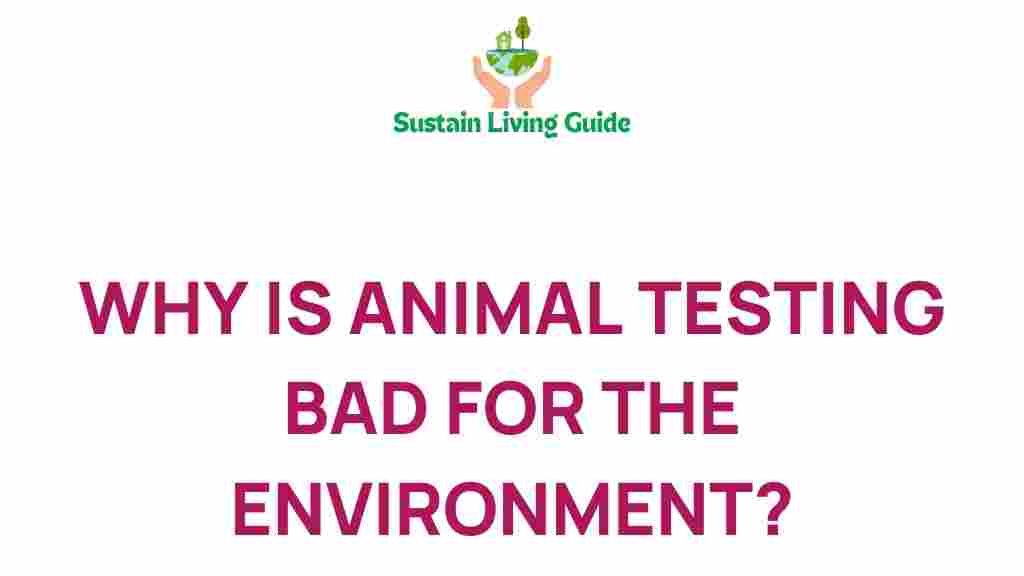The Hidden Environmental Costs of Animal Testing
Animal testing has long been a controversial practice, primarily focused on its ethical implications and the welfare of the animals involved. However, there is another, less discussed aspect of this practice that warrants attention: its environmental impact. The hidden environmental costs of animal testing can be significant, affecting ecosystems, biodiversity, and contributing to pollution. In this article, we will explore the various ways in which animal testing affects the environment, the steps involved in the process, and how we can mitigate these impacts.
Understanding Animal Testing
Animal testing refers to the use of non-human animals in experiments and research to assess the safety and efficacy of products, including pharmaceuticals, cosmetics, and chemicals. This practice has been a cornerstone of scientific research for decades, but it raises serious ethical concerns regarding the treatment of animals and the ecological footprint of such activities.
Here are some key statistics to consider:
- Approximately 100 million animals are used in testing each year in the United States alone.
- Animal testing can consume vast amounts of resources, including water, energy, and materials.
- It contributes to waste generation, which can lead to landfills and pollution.
The Environmental Impact of Animal Testing
The environmental costs associated with animal testing can be broken down into several categories:
1. Resource Consumption
Animal testing requires significant resources, including:
- Water: Large volumes of water are used for cleaning, feeding, and maintaining animal habitats.
- Energy: Laboratories consume energy for heating, cooling, and operating complex equipment.
- Materials: The construction and maintenance of animal facilities use a variety of materials that contribute to deforestation and habitat destruction.
2. Waste Generation
The waste generated from animal testing can be substantial. This includes:
- Biological waste: Animal remains, bedding, and other biological materials require careful disposal to prevent contamination.
- Chemical waste: The chemicals used in testing can be hazardous and must be handled and disposed of properly to avoid environmental damage.
3. Pollution
Animal testing can contribute to pollution through:
- Water pollution: Improper disposal of waste can lead to contamination of local water sources.
- Air pollution: Laboratories may release volatile compounds that contribute to air quality degradation.
The Step-by-Step Process of Animal Testing
To understand the environmental costs better, it’s important to look at the step-by-step process involved in animal testing:
- Planning and Design: Researchers design experiments that often require specific species and numbers of animals.
- Facility Preparation: Laboratories and animal housing facilities are constructed, consuming resources and energy.
- Animal Procurement: Animals are sourced from breeding facilities or suppliers, which can also have environmental impacts.
- Conducting Tests: Testing procedures often involve procedures that can harm or kill animals, leading to waste generation.
- Data Analysis: After testing, researchers analyze data, which may involve further resource use.
- Disposal of Animals: The disposal of animal remains requires careful management to mitigate environmental risks.
Troubleshooting the Environmental Impact
As society moves toward more sustainable practices, it’s essential to consider ways of mitigating the environmental costs of animal testing. Here are some strategies:
- Implement Alternative Testing Methods: Explore and invest in in vitro, computer modeling, and other non-animal testing methods to reduce the need for animal subjects.
- Optimize Resource Use: Laboratories can adopt green practices to minimize water and energy consumption.
- Proper Waste Management: Develop stringent waste disposal protocols to prevent pollution and manage biological and chemical waste effectively.
- Transparency and Reporting: Encourage organizations to disclose their animal testing practices and environmental impacts.
Ethical Considerations and the Future of Animal Testing
The ethics of animal testing are being scrutinized more than ever. As consumers become more aware of the environmental costs associated with this practice, there is a growing demand for transparency and alternatives. Companies that rely on animal testing may face backlash from environmentally conscious consumers, prompting a shift towards more sustainable practices.
For future considerations, it’s crucial to:
- Invest in research for alternative testing methods that do not involve animals.
- Educate researchers and industry professionals about the environmental impacts of animal testing.
- Encourage regulatory bodies to support and approve alternative testing methods.
Conclusion
Animal testing is often viewed through the lens of ethics and animal welfare, but it is essential to recognize the hidden environmental costs associated with this practice. From resource consumption to pollution, the impact of animal testing extends beyond the laboratory and into our ecosystems. By understanding these costs and taking action to mitigate them, we can work towards a more sustainable future.
To learn more about sustainable practices in research, check out this resource.
As we move forward, it is vital for researchers, companies, and consumers alike to advocate for alternatives to animal testing, ensuring that scientific progress does not come at the expense of our environment.
For more information on the environmental impact of various industries, visit this site.
This article is in the category Eco-friendly and created by SustainLivingGuide Team
